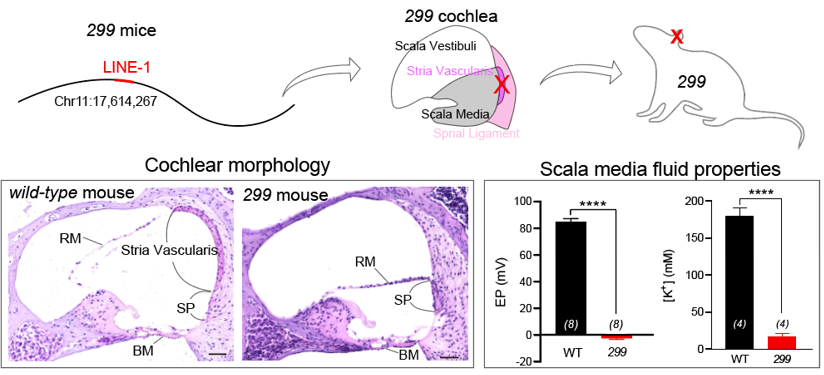Hearing is critical for an animal to communicate with other animals and the surrounding environment. To gain better hearing sensitivity, energetic and metabolic supplies are crucial for the cochlea to develop a blood-labyrinth barrier containing abundant capillaries and cellular compartments. Importantly, the stria vascularis, the power plant of the cochlea, generates a +80 mV endocochlear potential and a 150 mM potassium concentration in the cochlear scala media. Dysregulation of ion and potential homeostasis in the scala media is the most prevalent cause of hearing loss in mammals.
Recently, Dr. Wei Xiong's Group in the School of Life Sciences-IDG/McGovern Institute for Brain Research at Tsinghua University reported a novel mouse model for studying stria-vascularis associated deafness. On 9/28, the research article entitled “An L1 retrotransposon insertion induced deafness mouse model for studying the development and function of the cochlear stria vascularis” was published in PNAS.

Figure (Top panel) An LINE-1 retrotransposon insertion in Chr11 induces loss of stria vascularis in cochlea, which causes deafness of the 299 mice. (Bottom left panel) Histological study shows loss of stria vascularis. (Bottom right panel) In vivo electrophysiology study shows the loss of endocochlear potential (EP) and the potassium concentration ([K+]) in the cochlear scala media.
From a mouse genetic screen, the authors characterized a mouse line, named 299, that displays a profound hearing impairment. Histology suggests that 299 mutant mice carry a severe congenital structural defect of the stria vascularis. In vivo recording of 299 mice using double-barreled electrodes shows that the endocochlear potential is abolished and the potassium concentration is reduced to ~ 20 mM in the scala media, a stark contrast to the +80 mV endocochlear potential and the 150 mM potassium concentration present in healthy control mice.
Genomic analysis revealed a roughly 7 kb long interspersed nuclear element (LINE-1 or L1) retrotransposon insertion on chromosome 11. Strikingly, deletion of this L1 retrotransposon insertion from chromosome 11 restored the hearing of 299 mutant mice.
Based on 299 mice, the authors studied the development of the stria vascularis and how loss of the stria vascularis affects the morphology and function of the hair bundle of hair cells. Using differential transcriptome analysis, the authors reported a list of genes related to stria vascularis development and function, which paves the road for future stria-vascularis study.
In summary, the authors have characterized a mouse model that enables study of stria vascularis development and fluid homeostasis in the cochlear scala media. The work identifies an LINE-1 retrotransposon insertion mutation that is responsible for complete stria-vascularis loss of function. The study further highlights potential candidate genes linked with the stria vascularis.
This study was mainly finished by two Ph.D. students, Chenmeng Song and Jie Li, who serve as the co-first authors in the paper. The co-authors are Shuang Liu, Hanqing Hou, Tong Zhu, Jiaofeng Chen, and Lian Liu in the Xiong laboratory. Dr. Yichang Jia in the School of Medicine has provided kind help for mouse genetics.
Article link: https://www.pnas.org/content/118/40/e2107933118
Editors: Li Han John Olbrich

